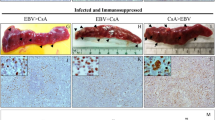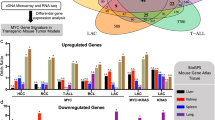Abstract
Angiogenesis was identified as an early consequence of myc gene overexpression in two models of retroviral lymphomagenesis. Avian leukosis virus (ALV) induces bursal lymphoma in chickens after proviral c-myc gene integration, while the HB-1 retrovirus carries a v-myc oncogene and also induces metastatic lymphoma. Immunohistochemical studies of the effects of increased c-myc or v-myc overexpression revealed early angiogenesis within myc-transformed bursal follicles, which persisted in lymphomas and metastases. Abnormal vessel growth was consistently detected within 13 days after transplantation of a few myc-overexpressing progenitors into ablated bursal follicles, suggesting that these angiogenic changes may support the initial expansion of tumor precursors, as well as later stage lymphomagenesis. Conditioned media from myc-overexpressing B cell lines promoted proliferation of vascular endothelium in vitro, while media from B cells expressing low myc levels showed little effect. Moreover, ectopic myc overexpression in the low myc B cell lines increased production of the endothelial growth activity, indicating that myc induces secretion of angiogenic factors from B cells. These findings demonstrate that myc overexpression in lymphocytes generates an angiogenic phenotype in vitro as well as in vivo.
This is a preview of subscription content, access via your institution
Access options
Subscribe to this journal
Receive 50 print issues and online access
$259.00 per year
only $5.18 per issue
Buy this article
- Purchase on Springer Link
- Instant access to full article PDF
Prices may be subject to local taxes which are calculated during checkout




Similar content being viewed by others
References
Bister K, Jansen HW, Graf T, Enrietto P and Hayman MJ . 1983 J Virol 46: 337–346
Bouck N, Stellmach V and Hsu SC . 1996 Adv Cancer Res 69: 135–174
Bowers WJ, Baglia LA and Ruddell A . 1996 J Virol 70: 3051–3059
Cooper MD, Payne LN, Dent PB, Burmester BR and Good RA . 1968 J Natl Cancer Inst 41: 373–378
Ewert DL, Avdalovic N and Goldstein C . 1989 Virology 170: 433–441
Ewert DL and deBoer GF . 1988 Adv Vet Sci Comp Med 32: 37–55
Gong M, Semus HL, Bird KJ, Stramer BJ and Ruddell A . 1998 J Virol 72: 5517–5525
Grandori C and Eisenman RN . 1997 Trends Biochem Sci 22: 177–181
Hanahan D and Folkman J . 1996 Cell 86: 353–364
Hann SR, Abrams HD, Rohrschneider LR and Eisenman RN . 1983 Cell 34: 789–798
Henriksson M and Luscher B . 1996 Adv Cancer Res 68: 110–182
Holash J, Wiegand SJ and Yancopoulos GD . 1999 Oncogene 18: 5736–5762
Iritani BM and Eisenman RN . 1999 Proc Natl Acad Sci USA 96: 13180–13185
Kerbel RS, Viloria-Petit A, Okada F and Rak J . 1998 Mol Med 4: 286–295
Kraemer M, Tournaire R, Dejong V, Montreau N, Briane D, Derbin C and Binetruy B . 1999 Cell Growth Differ 10: 193–200
Lewis RB, McClure J, Rup B, Niesel DW, Garry RF, Hoelzer JD, Nazerian K and Bose HR . 1981 Cell 25: 421–431
Neiman P, Wolf C, Enrietto PJ and Cooper GM . 1985 Proc Natl Acad Sci USA 82: 222–225
Neiman PE . 1994 Adv Immun 56: 467–484
Neiman PE, Thomas SJ and Loring G . 1991 Proc Natl Acad Sci USA 88: 5857–5861
Nesbit CE, Tersak JM and Prochownik EV . 1999 Oncogene 18: 3004–3016
Pelengaris S, Littlewood T, Khan M, Elia G and Evan G . 1999 Molec Cell 3: 565–577
Perez-Atayde AR, Sallan SE, Tedrow U, Connors S, Allred E and Folkman J . 1997 Am J Pathol 150: 815–821
Ribatti D, Nico B, Vacca A, Marzullo A, Calvi N, Roncali L and Dammacco F . 1998 Br J Cancer 77: 1900–1906
Tikhonenko AT, Black DJ and Linial ML . 1996 J Biol Chem 271: 30741–30747
Vacca A, Ribatti D, Iurlaro M, Albini A, Minischetti M, Bussolino F, Pellegrino A, Ria R, Rusnati M, Presta M, Vincenti V, Persico MG and Dammacco F . 1998 Inter J Clin Lab Res 28: 55–68
Vacca A, Ribatti D, Ruco L, Giacchetta F, Nico B, Quondamatteo F, Ria R, Iurlaro M and Dammacco F . 1999 Br J Cancer 79: 965–970
Acknowledgements
We thank Drs Helene Sage, Patricia Parsons-Wingerter and Mark Groudine for their helpful suggestions, Andrei Tikhonenko for generously providing advice and tsp-1 analysis, and Kelly Bird, Sandra Jo Thomas and Gilbert Loring for technical assistance. This work was supported by NCI RO1 grant CA68328 to A Ruddell and NCI R01 grant CA20068 to P Neiman.
Author information
Authors and Affiliations
Rights and permissions
About this article
Cite this article
Brandvold, K., Neiman, P. & Ruddell, A. Angiogenesis is an early event in the generation of myc-induced lymphomas. Oncogene 19, 2780–2785 (2000). https://doi.org/10.1038/sj.onc.1203589
Received:
Revised:
Accepted:
Published:
Issue Date:
DOI: https://doi.org/10.1038/sj.onc.1203589
Keywords
This article is cited by
-
An essential role for the immune system in the mechanism of tumor regression following targeted oncogene inactivation
Immunologic Research (2014)
-
Combination of sorafenib and angiotensin-II receptor blocker attenuates preneoplastic lesion development in a non-diabetic rat model of steatohepatitis
Journal of Gastroenterology (2014)
-
Branched-chain amino acids suppress insulin-resistance-based hepatocarcinogenesis in obese diabetic rats
Journal of Gastroenterology (2009)
-
MicroRNAs Regulate Ocular Neovascularization
Molecular Therapy (2008)
-
Augmentation of tumor angiogenesis by a Myc-activated microRNA cluster
Nature Genetics (2006)



